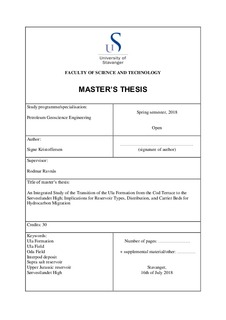| dc.contributor.advisor | Ravnås, Rodmar | |
| dc.contributor.author | Kristoffersen, Signe | |
| dc.coverage.spatial | North Sea, Central Graben | nb_NO |
| dc.date.accessioned | 2018-09-18T07:33:59Z | |
| dc.date.available | 2018-09-18T07:33:59Z | |
| dc.date.issued | 2018-07 | |
| dc.identifier.uri | http://hdl.handle.net/11250/2563078 | |
| dc.description | Master's thesis in Petroleum Geosciences Engineering | nb_NO |
| dc.description.abstract | The Upper Jurassic deposits of the Eastern Margin in the Central Graben were influenced by syn-depositional halokinesis, which in turn affected the partitioning of environments and the resulting stratigraphic architecture. The focus of this thesis is on the sandstones deposited along and on top of collapsing salt diapirs and salt walls, the so-called interpod deposits, in a transect from the Cod Terrace and onto the Sørvestlandet High. A refined understanding of the detailed stratigraphic architecture and facies partitioning in the reservoir is a prerequisite for risk mitigation of the Upper Jurassic play within this play segment. The main risks for the successful extension of the exploration model onto the Sørvestlandet High is the presence of reservoir and migration. The prime objective of the thesis is to gain insight into the distribution and connectivity of reservoir beds in a transect from the Ula Field to the Oda Field.
This has been accomplished using the following data: New 3D seismic data and older merged seismic data; all wells in the study area for seismic interpretation, with focus on three wells for correlation; and core data from three focus wells. Seismic interpretation was focused on defining seismic stratigraphic units within the Ula Formation which can be characterized via seismic facies and amplitude/frequency analysis to infer the stratigraphic architecture and architectural elements. Core interpretation was done by identifying variations in grainsize, trace fossils, fossil content, sedimentary structures, and bed stacking pattern(s) with emphasis on identifying architectural elements and depositional sub-environments.
The current preferred model of a storm influenced shoreface cannot account for the results found in this study. The older part of the Ula Formation show tidal dominance, and the younger part seem to be more affected by unidirectional currents. This indicates that the shoreface morphology has had great influence on the dominant process through abating the waves. Attribute maps indicate compound dunes deposited in a strait setting. Correlation and core interpretation suggest that there are fluvial systems bringing sediments out into the Cod Terrace, which could function as migration pathways from the Cod Terrace onto the Sørvestlandet High. Integration of wells and seismic has proved vital in this study as including the shoreface morphology has been a key part in understanding the system. | nb_NO |
| dc.language.iso | eng | nb_NO |
| dc.publisher | University of Stavanger, Norway | nb_NO |
| dc.relation.ispartofseries | Masteroppgave/UIS-TN-IER/2018; | |
| dc.subject | Ula Formation | nb_NO |
| dc.subject | Ula Field | nb_NO |
| dc.subject | Oda Field | nb_NO |
| dc.subject | Supra salt reservoir | nb_NO |
| dc.subject | Upper Jurassic reservoir | nb_NO |
| dc.subject | Sørvestlandet High | nb_NO |
| dc.subject | petroleum geology | nb_NO |
| dc.subject | petroleumsgeologi | nb_NO |
| dc.subject | interpod deposit | nb_NO |
| dc.title | An Integrated Study of the Transition of the Ula Formation from the Cod Terrace to the Sørvestlandet High; Implications for Reservoir Types, Distribution, and Carrier Beds for Hydrocarbon Migration | nb_NO |
| dc.type | Master thesis | nb_NO |
| dc.subject.nsi | VDP::Teknologi: 500::Berg‑ og petroleumsfag: 510::Geoteknikk: 513 | nb_NO |
| dc.subject.nsi | VDP::Matematikk og Naturvitenskap: 400::Geofag: 450::Petroleumsgeologi og -geofysikk: 464 | nb_NO |
